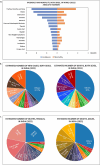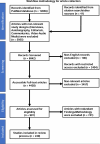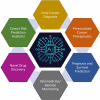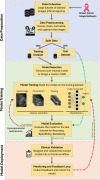Role of AI in empowering and redefining the oncology care landscape: perspective from a developing nation
- PMID: 40103737
- PMCID: PMC11913822
- DOI: 10.3389/fdgth.2025.1550407
Role of AI in empowering and redefining the oncology care landscape: perspective from a developing nation
Abstract
Early diagnosis and accurate prognosis play a pivotal role in the clinical management of cancer and in preventing cancer-related mortalities. The burgeoning population of Asia in general and South Asian countries like India in particular pose significant challenges to the healthcare system. Regrettably, the demand for healthcare services in India far exceeds the available resources, resulting in overcrowded hospitals, prolonged wait times, and inadequate facilities. The scarcity of trained manpower in rural settings, lack of awareness and low penetrance of screening programs further compounded the problem. Artificial Intelligence (AI), driven by advancements in machine learning, deep learning, and natural language processing, can profoundly transform the underlying shortcomings in the healthcare industry, more for populous nations like India. With about 1.4 million cancer cases reported annually and 0.9 million deaths, India has a significant cancer burden that surpassed several nations. Further, India's diverse and large ethnic population is a data goldmine for healthcare research. Under these circumstances, AI-assisted technology, coupled with digital health solutions, could support effective oncology care and reduce the economic burden of GDP loss in terms of years of potential productive life lost (YPPLL) due to India's stupendous cancer burden. This review explores different aspects of cancer management, such as prevention, diagnosis, precision treatment, prognosis, and drug discovery, where AI has demonstrated promising clinical results. By harnessing the capabilities of AI in oncology research, healthcare professionals can enhance their ability to diagnose cancers at earlier stages, leading to more effective treatments and improved patient outcomes. With continued research and development, AI and digital health can play a transformative role in mitigating the challenges posed by the growing population and advancing the fight against cancer in India. Moreover, AI-driven technologies can assist in tailoring personalized treatment plans, optimizing therapeutic strategies, and supporting oncologists in making well-informed decisions. However, it is essential to ensure responsible implementation and address potential ethical and privacy concerns associated with using AI in healthcare.
Keywords: artificial intelligence; cancer management; developing nation; digital health; personalized medicine.
© 2025 Goel, Bhaskar, Kumar, Singh, Amanullah, Dhar and Karmakar.
Conflict of interest statement
The authors declare that the research was conducted in the absence of any commercial or financial relationships that could be construed as a potential conflict of interest.
Figures








Similar articles
-
India's Potential as a Leader in Cancer Care Progress in the Future: A Synthetic Interdisciplinary Perspective.Cureus. 2024 Oct 5;16(10):e70892. doi: 10.7759/cureus.70892. eCollection 2024 Oct. Cureus. 2024. PMID: 39376975 Free PMC article. Review.
-
Artificial intelligence (AI) in restorative dentistry: current trends and future prospects.BMC Oral Health. 2025 Apr 18;25(1):592. doi: 10.1186/s12903-025-05989-1. BMC Oral Health. 2025. PMID: 40251567 Free PMC article. Review.
-
AI-driven biomarker discovery: enhancing precision in cancer diagnosis and prognosis.Discov Oncol. 2025 Mar 13;16(1):313. doi: 10.1007/s12672-025-02064-7. Discov Oncol. 2025. PMID: 40082367 Free PMC article.
-
Advancing the frontier of artificial intelligence on emerging technologies to redefine cancer diagnosis and care.Comput Biol Med. 2025 Jun;191:110178. doi: 10.1016/j.compbiomed.2025.110178. Epub 2025 Apr 13. Comput Biol Med. 2025. PMID: 40228444 Review.
-
Artificial Intelligence and Machine Learning in Pharmacological Research: Bridging the Gap Between Data and Drug Discovery.Cureus. 2023 Aug 30;15(8):e44359. doi: 10.7759/cureus.44359. eCollection 2023 Aug. Cureus. 2023. PMID: 37779744 Free PMC article. Review.
Cited by
-
Bridging technology and medicine: artificial intelligence in targeted anticancer drug delivery.RSC Adv. 2025 Aug 4;15(34):27795-27815. doi: 10.1039/d5ra03747f. eCollection 2025 Aug 1. RSC Adv. 2025. PMID: 40761897 Free PMC article. Review.
-
The Integration of Artificial Intelligence Into Precision Medicine for Neuro-Oncology: Ethical, Clinical, and Nursing Implications in Immunotherapy Care.Cureus. 2025 May 29;17(5):e85024. doi: 10.7759/cureus.85024. eCollection 2025 May. Cureus. 2025. PMID: 40443837 Free PMC article. Review.
References
-
- The World Bank. Population (total - India) (2023). Available online at: https://data.worldbank.org/indicator/SP.POP.TOTL?locations=IN (accessed May 10, 2024).
-
- The Global Health Observatory, WHO. Medical doctors (per 10000 population) (2023). Available online at: https://www.who.int/data/gho/data/indicators/indicator-details/GHO/medic... (accessed May 10, 2024).
Publication types
LinkOut - more resources
Full Text Sources

